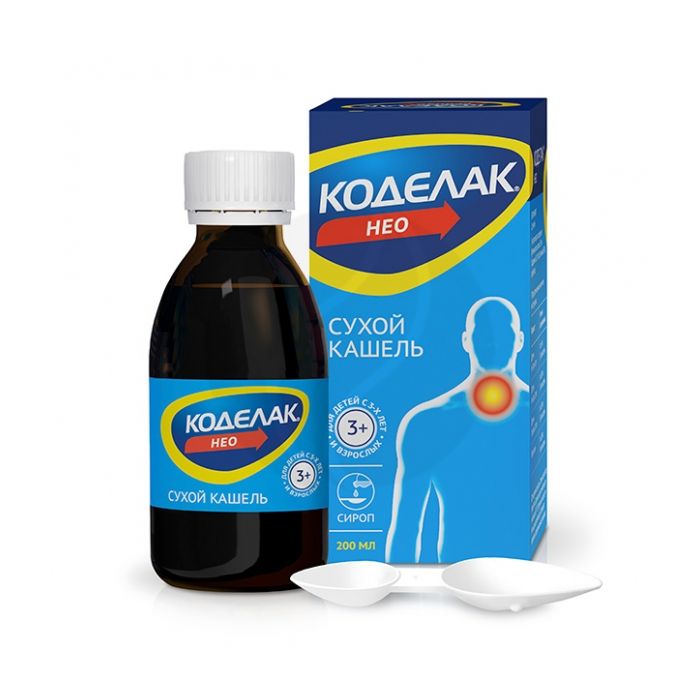Codelac Neo syrup, 200 ml
Expiration Date: 05/2027
Russian Pharmacy name:
Коделак Нео сироп, 200 мл
-Dry cough of any etiology (with colds, flu, whooping cough and other conditions);
- suppression of cough in the preoperative and postoperative period, during surgery and bronchoscopy.
Inside, before meals.
If the cough persists for more than 5 days after starting treatment, you should consult a doctor.
Syrup
Children from 3 to 6 years old - 5 ml 3 times a day; from 6 to 12 years old - 10 ml 3 times a day; 12 years and older - 15 ml 3 times a day; adults - 15 ml 4 times a day.
When taking the drug, a measuring device should be used.
Syrup 5 ml
active substance:
butamirate citrate (in terms of 100% substance) 7.5 mg
excipients: sorbitol (Neosorb 70/70, sorbitol syrup) - 2025 mg; glycerol (glycerin) - 1450 mg; ethanol 95% (ethyl alcohol 95%) - 12.69 mg; sodium saccharinate - 3 mg; benzoic acid - 5.75 mg; vanillin - 3 mg; sodium hydroxide solution 30% - 1.55 mg; purified water - up to 5 ml
-Hypersensitivity to the components of the drug;
-pregnancy (I trimester);
-the period of breastfeeding;
- fructose intolerance (drops for oral administration, syrup);
-lactose intolerance, lactase deficiency, glucose-galactose malabsorption (modified release film-coated tablets)
-Children up to 2 months (drops for oral administration), up to 3 years (syrup), up to 18 years (modified release tablets, film-coated).
Pharmacodynamics
Butamirate, the active substance of CodelacЃ Neo, is a centrally acting antitussive agent. Does not apply to opium alkaloids, either chemically or pharmacologically. Does not form addiction or addiction.
Suppresses cough, having a direct effect on the cough center. It has a bronchodilating effect (expands the bronchi). Helps to facilitate breathing, improving spirometry (reduces airway resistance) and blood oxygenation (saturates the blood with oxygen).
Pharmokinetics
Suction
After oral administration, butamirate is rapidly and completely absorbed from the gastrointestinal tract. After taking 150 mg of butamirate, the maximum concentration of the main metabolite (2-phenylbutyric acid) in the blood plasma is reached after about 1.5 hours and is 6.4 ?g / ml.
Distribution and metabolism
Hydrolysis of butamirate initially to 2-phenylbutyric acid and diethylaminoethoxyethanol begins in the blood. These metabolites also have antitussive activity, and, like butamirate, to a large extent (about 95%) bind to plasma proteins, which causes their long half-life. 2-phenylbutyric acid is partially metabolized by hydroxylation.
With repeated administration of the drug, cumulation is not observed.
Withdrawal
The half-life of butamirate is 6 hours. Metabolites are excreted mainly by the kidneys. Moreover, 2-phenylbutyric acid is mainly excreted in the form associated with glucuronic acid.
Overdose
Symptoms: nausea, vomiting, drowsiness, diarrhea, dizziness, decreased blood pressure, impaired coordination of movements.
Treatment: activated charcoal, saline laxatives, symptomatic therapy (according to indications).
Side effects
From the nervous system:
Rarely: drowsiness, dizziness, which disappears when the drug is discontinued or the dose is reduced.
From the gastrointestinal tract:
Rarely: nausea, diarrhea.
On the part of the skin and subcutaneous tissues:
Rarely: urticaria, possibly the development of allergic reactions.
Special conditions
The syrup contains sodium saccharinate and sorbitol as sweeteners, so it can be used by patients with diabetes mellitus.
Due to the presence of ethyl alcohol in the composition of the drug, there is a danger when using the drug in patients with a tendency to develop drug dependence, with liver diseases, alcoholism, epilepsy, brain diseases, pregnant women and children.
There is no data on the safety of the drug during pregnancy and its passage through the placental barrier. The use of the drug in the first trimester of pregnancy is contraindicated. In the II and III trimesters of pregnancy, the use of the drug is possible taking into account the ratio of benefits to the mother and the potential risk to the fetus. The penetration of the drug into breast milk has not been studied, therefore, the use of the drug during breastfeeding is not recommended.
Pregnancy (II and III trimesters).
Due to the presence of ethyl alcohol in the composition of the drug, use with caution in patients with a tendency to develop drug dependence, with liver diseases, alcoholism, epilepsy, brain diseases, pregnant women and children.
It is recommended to refrain from driving vehicles and engaging in other potentially hazardous activities that require increased concentration of attention and speed of psychomotor reactions, since the drug can cause dizziness and drowsiness.
Drug interactions
No drug interactions have been reported for butamirate. During the period of drug treatment, it is not recommended to consume alcoholic beverages, as well as drugs that depress the central nervous system (hypnotics, antipsychotics, tranquilizers and other drugs).
Due to the fact that butamirate suppresses the cough reflex, the simultaneous use of expectorants should be avoided in order to avoid the accumulation of sputum in the respiratory tract with the risk of bronchospasm and respiratory tract infection.

